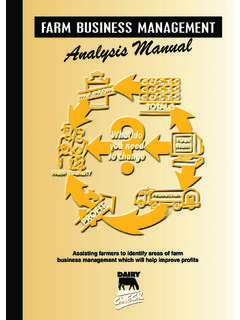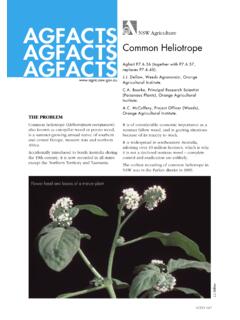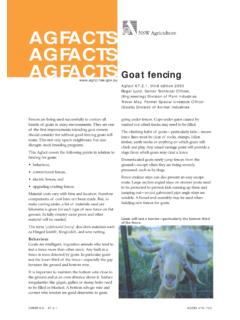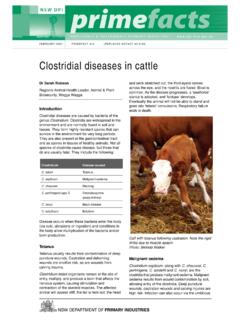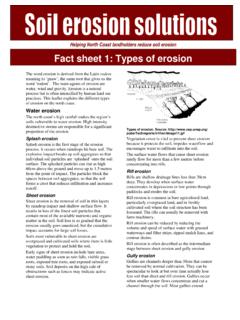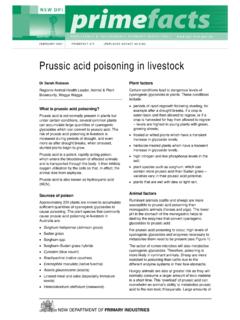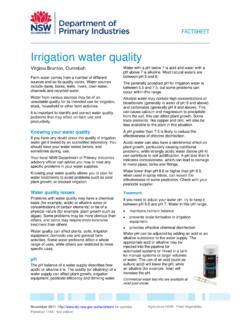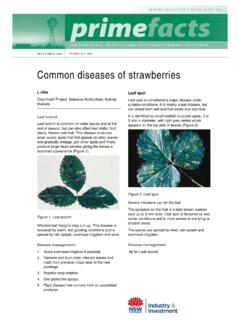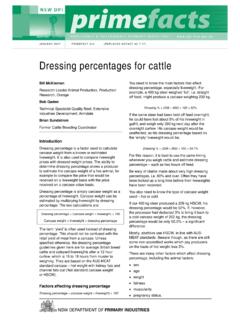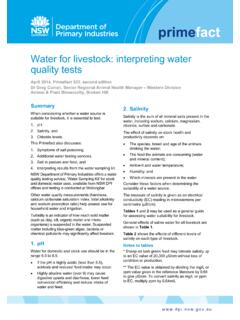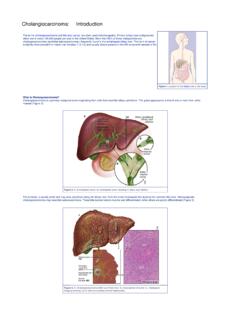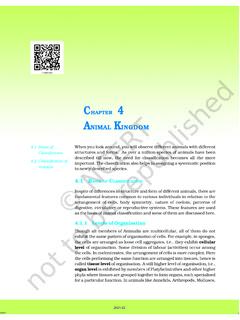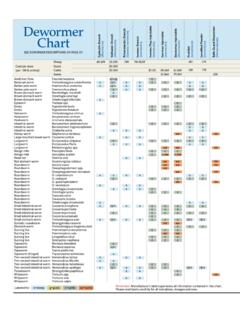Transcription of WormTest for Livestock and Guide to Egg Counts
1 FEBRUARY 2007 PRIMEFACT 480 (REPLACES AGNOTE DAI-308) WormTest for Livestock and Guide to egg countsStephen Love State Worm Control Coordinator, Extensive Industries Development, Armidale Dr Gareth Hutchinson Research Officer, Health Science, Strategic Alliances & Evaluation, Menangle NSW Department of Primary Industries veterinary laboratories at Camden, Orange and Wollongbar offer a number of tests that help farmers to control worms in sheep, cattle and other farmed animals. WormTest , which is used to monitor worm egg Counts , is the most frequently used test. It is an invaluable tool to help achieve sustainable worm control. WormTest monitoring for worms This test is used to monitor worms and liver and stomach fluke in a mob of cattle, sheep, goats or alpaca. Worm egg and fluke egg Counts are taken from dung samples submitted to the laboratory in a WormTest collection kit.
2 Within 24 hours of the samples arriving at the laboratory, egg count results are faxed or mailed to farmers, and to their advisers if requested. The type of roundworms present can also be identified. For most roundworms, this requires culturing worm eggs and examining the larvae which hatch, so a further 10 days is required for the worm type result. The type of fluke eggs present liver or stomach fluke is determined during the egg counting stage. WormTest kits are available from Rural Lands Protection Boards, rural suppliers and NSW DPI. Each kit includes instructions and an information sheet, prepaid postage to the laboratory, a mailing container, a glove and 10 sample containers. Private laboratories and consultants may also provide a similar service. Sampling Samples can be collected from the rectum of animals in a race, or in the paddock.
3 To collect dung samples in the paddock, muster a large number of the mob to a clean corner of a paddock for 10 minutes and then let them drift away quietly. Young animals, such as weaners, are an important group to sample because they tend to be quite vulnerable to worms. However, it may be necessary to sample more than one mob. Fresh, clean dung samples can then be collected from the ground, avoiding soil. Ten samples from separate sheep are required and sufficient dung to fill each sample container in the WormTest kit should be collected. For cattle, take 2 3 small grabs from each dung pat rather than one large sample. Within 24 hours of collection fill out the kit s information sheet and post it with the samples to the laboratory. Keep samples cool but do not refrigerate, as this may affect further development of eggs.
4 WormTest value for money WormTest is good value for money. It could save you the expense of unnecessary drenching or using the wrong drench. It can help you to forestall a disaster due to heavy worm infection. WormTest can be used as a simple and quick way to check drench effectiveness. Collect samples 10 14 days after using a particular drench longer for long-acting drenches. WormTest is a useful tool to monitor your worm control program. liver fluke testing Different techniques are used for egg Counts for fluke and roundworm. The test for fluke is very reliable for sheep where significant numbers of fluke eggs are shed in faeces. Bulk faecal pools are sufficient, with two pools each representing five animals. In cattle, the fluke test is less reliable due to the less regular shedding and low numbers of fluke eggs.
5 Five bulk pools, each pool representing samples from two cattle, are usually recommended. The relationship between fluke egg Counts and numbers of adult flukes is poor. Even low egg numbers indicate that the animals have been exposed to infection, and the need for control and treatment programs. Eggs are not produced for 12 to 16 weeks after infection. By this time immature flukes may have already caused significant damage. Blood tests (ELISA) detect antibodies produced in response to fluke infections from as early as two weeks after infection. These tests are available at NSW Department of Primary Industries laboratories. These tests are considered as herd or flock tests and sufficient numbers of blood samples are required ideally 12 15 per flock/herd. WormTest gold or basic? WormTest gold WormTest Gold is the traditional WormTest .
6 You get 10 individual egg Counts results include the average egg count and the range. This provides you and your adviser with information about the variability of numbers of worm eggs present in the dung of the mob. For example, a high count may mean that one animal was missed at the last drench, not that the whole mob is wormy. If worm type is requested (that is, larval culture and differentiation), dung is pooled from the 10 animals and determine the type of worms present in the mob. WormTest basic The laboratory combines dung from five animals and thus provides two Counts per 10 dung samples. The laboratory determines the average of the two Counts . Thus you lose the detail of the individual Counts , but can monitor for a lower cost. If type is requested, dung is pooled as above.
7 Which WormTest should you choose? The choice is best made by you with help from your adviser. Your adviser may have visited your farm and is best placed to know local conditions. By discussing your management objectives with your local adviser you will receive the best advice on how worms should be managed on your property. Basic is useful when routinely monitoring less susceptible stock, such as dry ewes and mature wethers. Gold. Consider Gold for susceptible stock, such as pregnant or lactating ewes, and weaners; or to confirm the effectiveness of your drenches; or at other critical times where detailed information is required. NSW DPI strongly recommends that you consult a veterinarian, or other suitably qualified adviser, for advice on monitoring and interpretation of the results. Interpreting roundworm egg count results It is very difficult to give hard and fast rules on interpreting egg Counts , as there are so many variables to consider.
8 Age of animals Adult dry animals in good condition tolerate worms much better than young or poor animals. In the case of extensively grazed cattle, adults often require little or no drenching except where liver fluke is a problem. Cattle up to two years of age are likely to need drenching, but egg Counts may not be a reliable indicator of actual worm burdens in animals older than 9 10 months. An adult occasionally may be wormy but yet have low egg Counts . In such case, local expert advice, and possibly a diagnostic drench given to a small group of animals may be in order. Physiological status Late pregnant or lactating sheep have a temporary relaxation of immunity, so in these cases you may consider drenching at lower egg Counts than otherwise. Egg Counts in sheep summary <200 (epg) drench probably not required (exception: summer drenching in DrenchPlan areas) 200-500 epg seek advice >500 epg drench probably required For more information, see Table 1 Guide to worm egg Counts in sheep, or Table 2 Guide to egg Counts in = eggs per gram Host species Well grown cattle and sheep over two years of age develop some immunity to worms.
9 The immunity in cattle tends to be stronger than in sheep. Goats do not appear to develop a great deal of immunity, PRIMEFACT 480, WormTest FOR Livestock AND Guide TO EGG Counts 2 even when they reach adulthood. Host immunity will have a bearing on how you interpret egg Counts . Alpaca are generally resistant, due in part to their dunging habit of using latrines , but they can be infected with both cattle and sheep worm parasites. Alpaca in fluke -endemic areas should be monitored carefully, as the small size of their livers makes them particularly susceptible to the effects of liver fluke . Nutritional status Well nourished animals develop stronger immunity to worms faster and so withstand a worm challenge Table 1. Guide to worm egg Counts in sheep Worm egg count epg Interpretation/comments (see box page 4: NB Tables 1 and 2 are guides only ) 0-100* A good result.
10 There would be few situations where you would contemplate drenching at this level. Consider another WormTest 4 6 weeks after significant rain, or before a management event such as a summer drench, pre-lambing, prior to yarding, or when there are signs consistent with parasitism. Be aware, however, that sheep in some cases can get heavy worm burdens quickly before egg Counts rise. An example might be a thin-necked intestinal worm (Nematodirus) problem in young sheep following rain after a dry spell. 100-200* This range of egg Counts is still low, but can be a trigger to drench in certain situations such as the first or second summer drench in the DrenchPlan area of central and southern NSW. Traditionally summer drenches have been done in DrenchPlan areas if mean Counts exceeded 100 epg or thereabouts.
